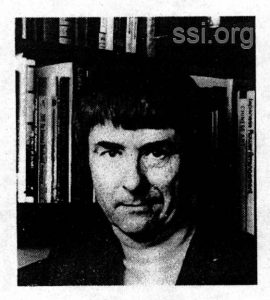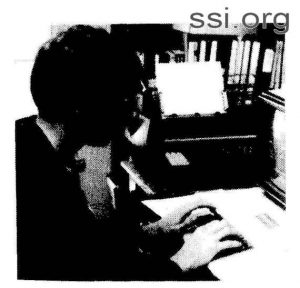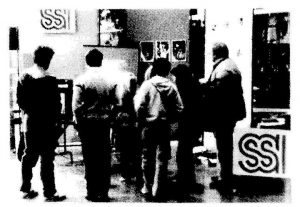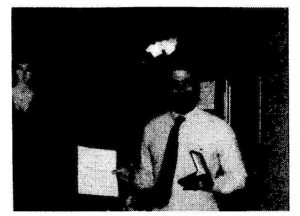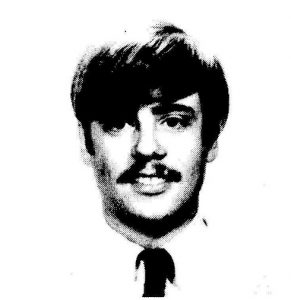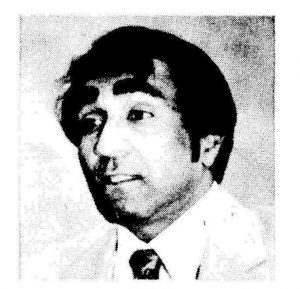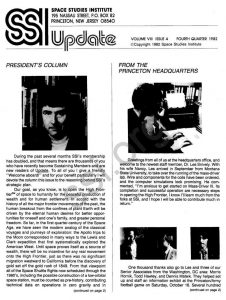
SSI UPDATE
SPACE STUDIES INSTITUTE
195 NASSAU STREET, P.O. Box 82
PRINCETON, NJ 08540
[[librarian note: This address is here, as it was in the original printed newsletter, for historical reasons. It is no longer the physical address of SSI. For contributions, please see this page]]
VOLUME VIII ISSUE 4
FOURTH QUARTER 1982
Copyright 1982 Space Studies Institute
PRESIDENT’S COLUMN
During the past several months SSI’s membership has doubled, and that means there are thousands of you who have recently become Sustaining Members and are new readers of Update. To all of you I give a friendly “Welcome aboard!” and for your benefit particularly I will devote the column this issue to the reasoning behind SSl’s strategic plan.
Our goal, as you know, is to open the High Frontier(sm) of space to humanity for the peaceful production of wealth and for human settlement. In accord with the history of all the major frontier movements of the past, the human breakout from the confines of planet Earth will be driven by the eternal human desires for better opportunities for oneself and one’s family, and greater personal freedom. So far, in the first quarter-century of the Space Age, we have seen the modern analog of the classical voyages and journeys of exploration: the Apollo trips to the Moon corresponded in many ways to the Lewis and Clark expedition that first systematically explored the American West. Until space proves itself as a source of wealth, there will be no incentive for any real movement onto the High Frontier, just as there was no significant migration westward to California before the discovery of gold set off the gold rush of 1849. From that viewpoint all of the Space Shuttle flights now scheduled through the 1980’s, including the possible construction of a low-orbital space station, must be counted as pre-history, contributing technical data on operations in zero gravity and in vacuum, but opening no significant new source of wealth from a source other than the Earth.
Within the next several decades the economic reasons for settlement of the High Frontier will be the historical reasons for construction of colonies: the opening up of new resources that return wealth to the homeland. In studies carried out for NASA in 1976 and 1977 under my direction we identified those resources, and our reviews since then have confirmed them: they are the solar energy that is a continuous, intense, reliable resource beyond the shadow of the Earth, and the material resources of the Moon and the asteroids, that have a value far beyond their earthly counterparts because of their location at the top rather than at the bottom of Earth’s gravitational field. At the rates corresponding to the flight cost of the Space Shuttle and an upper stage carried in its payload bay, that value is about $4,000 per pound or nine million dollars per ton for material at geosynchronous (24 hour) orbit or beyond – even if the material is no more exotic than oxygen, to be burned in rocket engines.
That is why our research at SSI concentrates on practical ways to bring large tonnages of material from the lunar surface out of the Moon’s weak gravity to high orbit (mass-driver research), on ways to separate that material into pure elements (chemical processing research), and on the most efficient way to seed at low cost a transport, processing and fabrication industry in space that can sustain its own further growth (SSI studies on partially automated industrial systems in space that are capable of partial selfreplication from lunar materials.) In all three of these areas much has already been accomplished under SSI support, and published in the technical literature.
That is also why we have identified solar power satellites (SPS) as the most likely large-scale product of industry in space. A solar power satellite would be a large product (100,000 tons) whose point of use would have to be high orbit, in permanent sunshine. It would have large value (approximately $10 billion per satellite). The product it would supply to Earth, electric power, is one that our planetary civilization will always need, and for which the market is large and increasing as the population grows and more nations make their way through the industrial transition toward a better living standard. And the SPS is an attractive product from SSI’s viewpoint for another reason: it is a peaceful product, not reasonably convertible in any way found so far into a weapon of war.
For all of these reasons, SSI has developed its strategy and chosen the research areas to which it gives highest priority for funding. And it is through that research, made possible by your support, that we can open the High Frontier for productive work and new opportunities for many thousands of people before this century ends.
-Gerard K. O’Neill
FROM THE PRINCETON HEADQUARTERS
Greetings from all of us at the headquarters office, and welcome to the newest staff member, Dr. Les Snively. With his wife Nancy, Les arrived in September from Montana State University, to take over the running of the mass-driver lab. Wire and components for the coils have been ordered, and the computer simulations look promising. He commented, “I’m anxious to get started on Mass-Driver III. Its completion and successful operation are necessary steps in opening the High Frontier. I know I’ll learn much from the folks at SSI, and I hope I will be able to contribute much in return.”
One thousand thanks also go to Les and three of our Senior Associates from the Washington, DC area: Morris Hornik, Todd Hawley, and Dennis Mateik. They helped set up and staff an information exhibit at the Princeton/Army football game on Saturday, October 16.
Several hundred people stopped by the booth to ask questions, view an excellent videotape prepared by Senior Associates Gregg and Maureen Maryniak and their Chicago Society for Space Studies group, and to collect SSI materials.
Another Senior Associate spreading the word is Jack Brisbin, from the Midwest. He prepared information folders and a display for Spaceweek Detroit, and sent us a list of participants to contact.
The Princeton area Amateur Astronomy Association included SSI materials in their booth at a local shopping mall, September 25 and 26.
Thanks go to Jay Albert for setting this up.
On October 6, William B. O’Boyle of O’Boyle Investments, Inc. became the first recipient of the Space Medal. Only two of these medals have been struck to date, in recognition of outstanding support during the earliest years of the Institute. Congratulations to Mr. 0 Boyle, and many thanks for his long standing support.
Good news for those of you waiting patiently for Or. O’Neill’s book, THE HIGH FRONTIER to return to print. The new, larger softcover format is available through SSI. See the order form on page 5. As a postage savings for you, we’re sending all books at the cheaper book rate, rather than priority mail unless requested.
And as a labor and bookkeeping cost reduction, our quarterly newsletter is going to a once-a-year renewal system. If you’ve renewed your Sustaining Membership this year since September 15, you’re not obligated to renew with this issue and will get another notice in November of 1983. For those of you who haven’t renewed yet, your notice is enclosed.
We also appreciate the extra gifts that have come in for the mass-driver project. This quarter you can still make an extra gift for that work by completing that section on the order form, page 5.
The enthusiastic response to our Recruitment Contest has prompted us to move the deadline to December 30. There are still a few recruiting packets left, so write for yours today, using the order form.
Abstracts are starting to arrive in response to the Call for Papers for the 1983 Space Manufacturing Conference. Session heads are being contacted, and the details are falling into place. The abstract deadline has been extended also, to December 31, to accommodate magazine meeting calendars. Authors of accepted papers will be contacted by the end of January. Final manuscripts are due March 18.
And once again, for the holidays, gift subscriptions are announced with attractive calligraphied cards. Make a present of the future to your friends and family this season.
GUEST COLUMN
James E. Byassee, Ph.D. is a practicing clinical and community psychologist living in Chapel Hill, N.C. He received his Ph.D. in psychology from the University of Louisville in 1975 and interned at the Dede Wallace Community Mental Health Center in Nashville, Tennessee. Dr. Byassee lived and practiced in the small community of Roanoke Rapids, N.C., and served as a community consultant to area schools, organizations, and groups, including the Haliwa-Saponi Indian Tribe. He has published research dealing with both service delivery systems and family systems, and has written two book chapters in the area of behavioral medicine. Currently, he is a Clinical Associate in the Division of Medical Psychology, Department of Psychiatry at Duke University Medical Center. Dr. Byassee is in the process of organizing an Interest network of psychologists focusing upon space communities and psychology.
COMMUNITY PSYCHOLOGY
Is it “jumping the gun” to move in our thinking from small scale scientific or research habitats to “New Towns” in space in the conceptualization of how human behavior is to be understood, guided or modified? Actually not. Already the area of ergonomics, the psychological study of the man-machine interface, historically active in the space program, has moved toward larger human resource applications. Human factors research and space medicine have also provided a considerable data base on the biological and psychological adaptation of individuals to space and space laboratory environments. As these environments and their populations diversify, so must our conceptual framework. The Space Operations Center, for example, conceived by the NASA Johnson Space Center, is designed to be able to service and assemble equipment in space. These new operations represent new tasks and behaviors to be performed by new types of space personnel. Larger numbers of people will be involved as well. As the diversity of personnel, types of behaviors and settings, and organizational variables increase, a “systems” perspective as opposed to the psychology of the individual will be required. As even more complex structures become seriously forecasted by governmental or industrial concerns, the need for a “community” psychology becomes even clearer.
Although the belief exists that the development of large scale space colonies is many decades away, the current and growing interest in this possibility is quite remarkable. Many writers have asserted that space colonies will some day play a substantial role in shaping the future of mankind. In a colony of 10,000 residents, like Dr. Gerard O’Neill’s “Island One,” sunlight, atmospheric composition and weather will be controlled. Access to the colony will be controlled, as will transportation population density, housing patterns, industrial and agribusiness activity. New forms of recreation, architecture, education, and communication have been predicted for these space citizens and their families. Yet, how will we measure and provide for the psychosocial needs of these inhabitants? How will the many types of citizens (e.g., manufacturing crews, research scientists and engineers, support staff, military personnel, small business operators, service delivery staff, and their families) provide input for decision making and the formulation of public policy? What kinds of social support mechanisms, governmental units and services, environmental designs, or even noise levels will be needed to develop what Dr. Seymour Sarason of Yale’s Psychoeducational Clinic calls an effective “sense of community”? What will be the distribution and arrangement of living and working structures? How will industrial consortiums and small scale government units be structurally organized to maximize their effectiveness and successful interface with the collective interests of space citizens? What are the most effective personal characteristics of colony inhabitants? What is the optimum interaction of these personal traits with the social and physical variables mentioned above? How will various cultural and social subgroupings affect community functioning?
Questions of this kind and countless others could be asked. Many may already be under study. However, it should be recognized that the application of psychological knowledge to these types of questions has already routinely been accomplished in various settings Earthside, and is already available as a considerable knowledge base for the “New Towns” of the future. Psychologists have participated heavily in the creative use of citizen input in designing communities and in providing feedback with regard to programs and services. Dr. Stan Murrell, a community psychologist at the University of Louisville has presented and evaluated a procedure for the systematic use of quantitative citizen input in formulating local government policy and in arranging responsive services. In another project, the NewCom program, a proposed model for new communities, he suggested the use of a “habitability survey” for citizens to regularly complete as a way of arranging specific feedback for corrective action in planning services and programs.
Dr. Donald Klein published a monograph while at Johns Hopkins University on the psychology of the planned community, showing the feasibility of using scientifically acquired data upon which to base ideas for community behavior and decision making. Community psychologists have worked along with architects, land use experts, road builders and other community planners in such planned communities as Columbia, Maryland. Especially in the “New Towns” concept, community psychology has demonstrated the need to utilize an interdisciplinary perspective, absorbing contributions from community planning, epidemiology, and architecture. The community psychologist knows the necessity of understanding economics, religion, geography, and politics.
What exactly is community psychology? Although an infant science, community psychology has evolved as an area of inquiry within the science of psychology that studies transactions among social and physical systems and their populations. It especially seeks to develop and evaluate interventions and plans which improve the “fit” between individuals and their physical or social “niche.” Spawned partially out of the community mental health movement of the 1960s, community psychology emphasizes a different conceptualization of man and his behavior. Rather than viewing behavior as a result of defenses against anxiety as might the psychoanalysts, or seeing man as a passive recipient of rewards and punishments as the behaviorists seem to, community psychology assumes that social and physical factors play a crucial role in determining the behavior of individuals within specific settings or networks of settings. Man’s psychosocial evolution therefore depends heavily upon social and physical variables which can be studied and modified.
Community psychologists have become involved in the assessment, education, and treatment of individuals and groups (such as students, prisoners, “target groups” of “at risk” individuals, etc.) by developing data-based interventions within the environment or social systems of populations of individuals. They have participated in the planning and organizing of various services and interventions in community settings as half-way houses, alternative institutions, schools, group homes, etc. They have studied and developed mental health education and consultation programs, evaluated and developed statewide service systems. Various psychological sub-disciplines have also provided literature and technology to the community approach, such as organizational and social psychology. Even the physiological effects of various types of social environments have been studied.
Psychology has been able to contribute to the quality of life in substantial ways in education, design of services and in the treatment of clinically suffering people. It has contributed substantially as well to the space program in studies of human performance especially. As do many other disciplines, it has a contribution to offer to the futures of space habitats. As a profession and area of inquiry, psychology must also prepare to step forward with the engineers and physicists already eager to build the “New Towns” of the future.
UNISPACE 82:
A Report of the Conference
Dr. Rashmi Mayur is a member of the Futurology Commission, government of India and serves on the Advisory Board of SSI. He served as the Vice President of the Global Futures Network of the Non-Governmental Organizations at UN/Space ’82, held this summer in Austria. Here is the report he filed from that Conference.
Never before has humankind confronted its future with more uncertainty than it does today. The world’s nations exist in unbelievably contradictory circumstances. Yet we also possess better knowledge of planetary problems, and more sophisticated technology than ever before. It is now increasingly realized that millions of years of confinement on planet Earth are about to end. We are on the threshold of a new era. Science and technology at humanity’s command today and in the future will take us far from the frontier of Earth, into space and beyond.
Our planet faces many crises: a burgeoning population, declining resources, a deteriorating environment, poverty and increasing militarism. New advances in genetics and electronics offer unparalleled and unexpected opportunities to solve these problems. And space science and technology provide new and powerful tools of development undreamed of only a few decades ago.
It was mainly to explore and identify the various potentials of outer space that the Second United Nations Conference on the Exploration and Uses of Outer Space (UNISpace 82) was held in Vienna, Austria from August 9-21, 1982.
The Conference was held 25 years after the launching of Sputnik, when, in practical terms, the space age was ushered in. During the last quarter century very few areas of human ventures have experienced such explosive developments with so many implications for our future, as the area of space.
Although the event passed relatively unnoticed by the rest of the world, it was as important as other conferences of the United Nations, including those on Environment, Science and Technology, Energy, and others. Originally it was sponsored by the Third World countries. Its primary objectives were to reach a consensus concerning international agreements for peaceful uses of outer space, and to evolve programs to accelerate advancements in the developing countries. It represented a unique opportunity to face the global problem of poverty with new technologies and knowledge never before available.
Of the 157 member countries of the UN, 94 participated in the official Conference, held at the Hafburg Convention Hall, and hosted by the Austrian government. In parallel sessions, a conference of Non-Governmental Organizations (NGO’s) met at the same time. Experts discussed substantive technical and philosophical issues concerning humanity and space. The Conferences were attended by approximately 1500 people from around the world at a cost of about $3 million, in addition to what each country and organization spent. A space exhibit organized by 25 countries including the United States, Canada, India, and the Soviet Union, and four international organizations, was also on display.
Of the issues discussed, the one which most concerns humanity is the deweaponization of space. A large number of non-governmental organizations and some of the world’s great thinkers, including Arthur C. Clarke of the United States and Dr. Oleg Gazenko of the Soviet Union spoke on the subject. While most of the NGOs wanted an agreement and even a treaty to ban the militarization of space, the UN Conference only expressed concern, without such an agreement. That was probably the tragedy and failure of the Conference. As the Chancellor of Austria and many delegates expressed, almost 75% of the space budgets of the two world superpowers appears to be for the militarization of space. Only the future will tell us where this will lead.
Conference participants gained new education and awareness in a field which seems remote to most of the citizens of the world. Carl Sagan, in a special lecture at the Conference, said that our Earth is a particle of dust in the universe. It is on this tiny speck that human beings with their unique intelligence are enacting a drama with far reaching consequences. It was pointed out in another lecture by Arthur C. Clarke that through space, reality will meet with dreams, and there will be no “frontiers” in space. All the frontiers are products of the limitations of our minds. Peter Glaser led a two-day program with eminent people in the field of energy. The NGO representative discussed the future development of energy in the Third World nations. In the last special lecture, Dr. Oleg Gazenko emphasized many biological changes due to man’s venture into space. He also felt that space may hold the answers for the cures for diseases and for feeding the many hungry people in the world.
Most nations are involved in space developments, directly or indirectly. As the Secretary General of the Conference, Dr. Yash Pal, put it, “Space activities are global in nature … applications of space seem to be most appropriate for the least developed parts of the world.”
The least developed part of the world today is far away from the unlimited potential of space for all of us. Communication, education, resource mapping, disaster warning, pest control, environmental planning, navigation, energy and agriculture, protection of forests, and security programs are possible for everyone. The third world countries cannot escape being in the mainstream of space development. Their survival and their future depends upon acquiring and applying space technologies for planning and development. Today only a few developing countries (Brazil, India, Indonesia, Pakistan and Nigeria) are seriously involved in space developments. Many of the developing nations are in the equatorial regions and lie below the geosynchronous orbit. They can exploit their advantageous position if they form regional space programs.
As an example, no European country individually could have become a space power equal to the two superpowers. But today the European Space Agency is a major force in positive space development. Similarly, as proposed at the Conference, there is a need for a Third World Space Agency. It can become not only an instrument of development in more than 100 countries in Africa, Asia and South America, but can also try to deter the superpowers from militarizing space and dividing the planet among themselves. If there is any message from the Conference for the developing nations, it is that their future lies in space. They must develop educational and training programs to use space technologies for solving their problems and become part of industrial civilization.
Space is no longer mythology or science fiction. Our Earth is in space. We just cannot escape space. For many decades we have faced problems, some of which seemed insoluble, due to limitations of Earth. With newer knowledge and ingenious technologies developed in space, we can solve them. It seems an insult to all our science and spirit that almost 70% of the people in developing countries are victims of deprivation, while the unlimited opportunities and resources of space lie idle, or may be used for the benefits of the few, or may be deployed for militarization.
The conclusion of UNISpace 82 is that mankind is at the crossroad of destiny, and that destiny will be determined for us by what Dr. Yash Pal called ‘space ethics.” Either together we build a beautiful civilization for all of us on our home planet and beyond in space colonies, or we are all in danger of perishing prematurely from stupidity.
The final outcome of the Conference will be submitted as a report to the UN General Assembly in November 1982. Specific recommendations will be listed for pursuing space activities more vigorously, for powerful developments through increased UN involvement, through private initiatives and through extensive non-governmental projects.
LECTURES
Dr. O’Neill’s winter lecture schedule follows. SSI Senior Associates will be notified by postcard of his lectures in their local areas. Lectures marked with an asterisk (*) are closed to the public.
1982
December 8 – University of Wisconsin at Stout, Menomonie, WI.
1983
February 4 – Arizona State University, Tempe, AZ..
February 16 – Rochester Museum and Science Center*, Rochester, NY.
March 3 – Delta College, University Center, Ml.
©space studies institute

